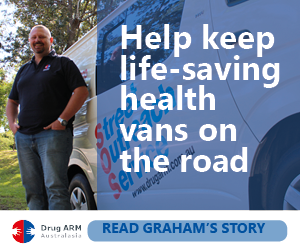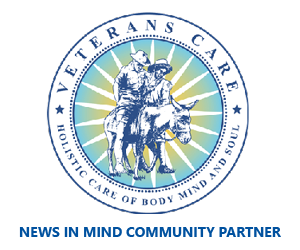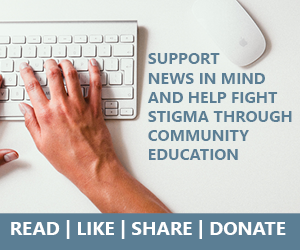Catherine feels ridiculous recounting her visceral fear now, but while she wasn’t having a heart attack, that moment changed things for her forever.
“Everything was closing down, the sound was muffled,” she told news.com.au. “Everything was drawing in on me, I couldn’t get my breath in. You don’t get enough oxygen.”
The panic attacks continued for another six months, to the point where she couldn’t leave the house. “It was probably one of the darkest times of my life,” she said. “I had a breakdown.
“I was very depressed. I didn’t want to leave the house or my husband.
“I’d be waking in the middle of the night with a panic attack. I’d be crawling on the floor.
“There’s a stigma attached. I was really scared it would happen in public. It was shame, it cripples you.”
Catherine had brought her son Jordan up alone, so suddenly becoming reliant on new husband Andoni was a shock. “I was a single mum, independent, to have someone look after me, I was really embarrassed. And he saw me in a different light, he didn’t see me as a strong woman, he saw me as a weak, frail thing.”
The mother of one had fallen victim to Australia’s workplace stress crisis, putting in longer and longer hours at the expense of her mental health, pushing herself to the point that she had developed chronic anxiety.

Catherine Plano had a terrifying panic attack on a train in New York. Source:Supplied to News.com.au
She now makes her mental health a priority, using meditation, writing and a healthy lifestyle to shift her thinking. She speaks openly about her struggles with anxiety, and says the number of people coming forward with their own stories only seems to be growing.
“It’s amazing how many people are talking about it now,” she said.
Mental health issues are the leading cause of sickness absence and long-term work incapacity in Australia — overtaking musculoskeletal problems in 2013 — and most developed countries.
And the problem is driving people to suicide at an unprecedented rate. Eight Australians die by their own hand each day: six of them men. For every person who succeeds, there are another 30 who attempt suicide, with 85,980 people in this country trying to take their own lives in any given year. It is the most common cause of death in Australians aged 15-44, more likely to kill you than a motor vehicle accident or skin cancer.
A massive 20 per cent of suicides are linked to work. At a summit in May, crisis support service Lifeline said we were facing a “national suicide emergency”.

The mother of one said it was hard going from high-flying, strong woman to feeling completely dependent on husband Andoni. Source: Supplied to News.com.au
It is one of the most critical threats to society — damaging our health and relationships, costing the economy and endangering our lives.
Mental health conditions such as depression and anxiety cost Australian businesses up to $12 billion.
Yet we don’t always treat the issue seriously. As formerly suicidal firefighter Peter Kirwan told us: “If you see someone with a broken arm, you help them lift things, but that doesn’t necessarily occur with mental illness because it’s invisible and people hide it.”
‘WE CAN’T MAKE IT RISK-FREE’
This week, news.com.au is running a series on work stress and suicide, meeting people who have developed severe work-related mental health disorders, contemplated suicide or loved someone who took their own life because of a job. We spoke to researchers and those on the front line trying to address this so-called “modern epidemic”.
The research shows there are a number of clear risk factors in a job that lead a person to develop mental health issues and potentially attempt suicide.
Samuel Harvey, a UNSW researcher exploring the issue for the Black Dog Institute, divides it into three main risk factors.
“One is job strain,” he told news.com.au. “A combination of a psychologically demanding workplace, combined with employees not having much control over what they do minute to minute, day to day.”
Job strain can involve a lack of resources, engagement, exposure to extreme stress and long hours.
Then there’s a lack of respect or value. This could involve being bullied, sexually harassed or ignored. Bosses who are not open or fair in their decision-making can generate feelings of resentment and misery in employees.
The third major factor is occupational uncertainty. Workers whose jobs are insecure are likely to be under more stress than others, particularly if finances are an issue. During the global financial crisis in 2008, as concerns over job security soared, deaths by suicide increased by almost 5000 across the developed world.
Job insecurity partially explains why low-paying contractors are at more risk of suicide than others, with construction workers having the highest rates of suicide in Australia. Farming and manufacturing are also high-risk roles.
Other jobs with elevated rates of suicide include doctors, nurses, vets, lawyers and bankers. This is attributed to high demand, long hours, hierarchy, gender norms and — in the case of medical professions — daily trauma and access to the means to take your life.
But the picture is far more complex than the type of job you do. “You can have two workers experiencing the same environment and it can cause problems for one and not the other,” said Dr Harvey. “That’s not to say we can’t, and employers in particular can’t, make it more mentally healthy, but we can’t make it risk-free.”
Poor mental wellbeing is typically the result of a combination of individual vulnerabilities, social factors and environmental triggers. Men are more at risk than women, and people living in rural areas are at more danger of suicide.
University of Melbourne epidemiologist Allison Milner told news.com.au: “I think of [suicide] in connection with things like the economy, I think of it in connection to the community, connection to whatever’s going on in society.
“It’s quite multilayered and it goes all the way down to what an individual is experiencing to what’s going on around them in terms of norms around help-seeking as well as the quality of their work, right up to the national economy and seeing how this is trickling down to affect workers.”
A difficult work situation could exacerbate other issues in someone’s life — whether a relationship breakdown, financial stress, bereavement, genetic predisposition to depression, substance abuse, isolation or sexual harassment.
“I think what we need to consider when we think about something like suicide is it has a massive ripple effect so, I don’t know about you, but I’ve lost someone in my life to suicide and I think about that quite often,” Dr Milner said. “So numbers don’t really provide a true indication of how much a suicide really affects workers and people around them.”
‘YOU LOVE WHAT YOU DO, YOU JUST KEEP PUSHING IT’
With one in every three people in any Australian workplace currently experiencing some kind of mental health challenge, we clearly need urgent action to tackle what the Black Dog Institute calls a “public health crisis”.
There are various programs in place through federal and state government, non-profits and private companies, but there is a lack of consistency, and some are far ahead of others.
The Centre of Research Excellence in Suicide Prevention notes that despite investment in suicide prevention activities and interventions, evidence suggests these have been largely ineffective, highlighting “the need to focus on strategies that are proven to work.”

Catherine now sees her struggles with anxiety as a gift, which has led her to change her approach to life. Source:Supplied to News.com.au
The experts say we need workers to prioritise their mental health and that of those around them, employers to create a supportive culture with universal support on an ongoing basis and structural change within industries, with the assistance of government. Vitally, we need to remove the culture of shame and be willing to address mental health as we would any other problem.
“I look on it as a gift,” said executive Catherine, now a successful speaker and author, who still occasionally suffers panic attacks. “Life is completely different.
“Health hadn’t been a priority. I was a single mum, a workaholic. I had all this pressure, I felt overwhelmed. You love what you do, you just keep pushing it.”
She now makes a point of switching off at 8.30pm, putting her phone in her study and not taking it out until after she has had eight hours sleep and meditated in the morning. She avoids her panic triggers, such as news stories about mothers getting shot in front of their children.
“How often do we get time out to pause?” she asked. “We live in a fast-paced environment, not conscious of what we’re thinking about, emotions are high. You’re contactable all the time.
“I think a lot of that is very aligned with social media, social pressure.
“Now I take a full day out, on Sunday I do things I love to do, I plan it in diary or it doesn’t happen. I take time off.”
If you or someone you know needs help, contact:
Lifelineon 13 11 14 or the Suicide Call Back Service1300 659 467 for 24-hour Australian counselling services.
Beyondblue(1300 22 4636) for 24-hour phone support, online chat, resources and apps.
Workplace Mental Health Institute on 02 8935 3885.
Mindout for mental health and suicide support for lesbian, gay, bisexual, transgender and intersex (LGBTI) people.
Kids Helpline1800 55 1800 — free confidential 24-hour counselling for young people aged 5 to 18.
Headspace offers online counselling for young people aged 12-25 andReachOut has online forums, chat and information about youth mental health.
This piece by was first seen on ‘News.com.au’ November 24, 2017.























